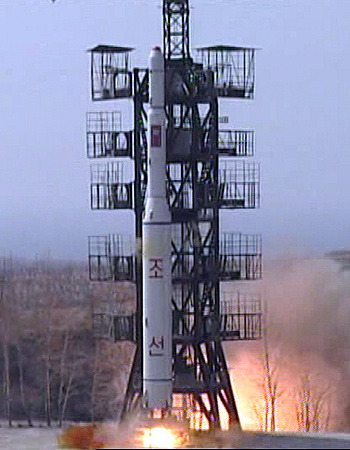
Following a recent set of bilateral talks between the US and North Korea (DPRK) in Beijing on February 23-24, the North Korean Foreign Ministry released a statement saying:
The DPRK, upon request by the US and with a view to maintaining positive atmosphere for the DPRK-US high-level talks, agreed to a moratorium on nuclear tests, long-range missile launches, and uranium enrichment activity at Yongbyon and allow the IAEA to monitor the moratorium on uranium enrichment while productive dialogues continue.
The US State Department announced that IAEA inspectors would also “confirm the disablement of the 5-MW reactor [at Yonbyon] and associated facilities.”
In return, the US will provide 240,000 metric tons of food, under the condition of strict monitoring to make sure it helps the starving DPRK population.
The discussions that led to this announcement were apparently underway for some time, and the announcement was delayed, rather than precipitated by, the death of Kim Jong Il in mid-December.
North Korean statements like these invite skepticism, but are positive steps. An earlier pledge kept plutonium-laden nuclear fuel rods locked up by international inspectors for a decade until, in a fit of pique at the Bush administration in 2005, Pyongyang expelled the inspectors and extracted the plutonium. This increased its stock of plutonium from enough for 1 or 2 nuclear weapons to enough for probably 8 to 10.
The missile launch moratorium is particularly interesting since it can cap Pyongyang’s missile capability and is readily verifiable by US early warning satellites. Previously, North Korea observed a flight test moratorium from September 1999 through July 2006, which it began when talks with the US about missile and nuclear issues seemed to be moving ahead under the Clinton administration. It announced it was no longer bound by the moratorium in March 2005, in response to the Bush administration’s lack of engagement on missiles.
While Pyongyang may continue ground testing of engines and other components, flight tests of new missiles are needed to verify that a full missile system works as intended. The problems North Korea has had with past flight tests illustrates the fact that you can’t skip this step and have any confidence that a launch will be successful—especially as you go to longer range missiles.
The next steps in the diplomatic process that the US should push for are:
- Stopping missile development, sales, and technical assistance
- Stopping the further production and deployment of missiles
- Reducing numbers of deployed missiles and dismantling missiles removed from deployment.
I discuss these steps and the status of North Korea’s missile program in a paper I wrote in 2009.
Verifying these further steps is more difficult and requires more intrusive measures than monitoring flight tests, but it is important to build into any agreement clear prohibitions on these activities and to push for on-site monitoring, as Pyongyang has been willing to allow the IAEA to do.
If successful, these efforts could help roll back the threat posed by North Korean missiles, and could help integrate North Korea into the international community. Ultimately, of course, the US may conclude that North Korea is not interested in negotiations and that a strategy of containment and isolation is the best it can do. But it makes no sense to start with such a strategy. A pragmatic, hard-nosed approach to national security requires that the US seriously pursue a policy of engagement with North Korea to find out if it will work.
For an update, click here.
